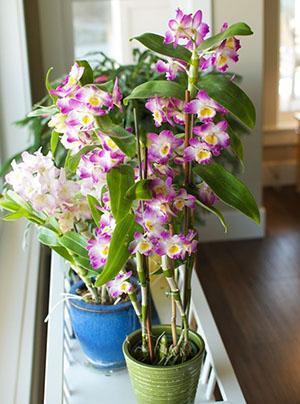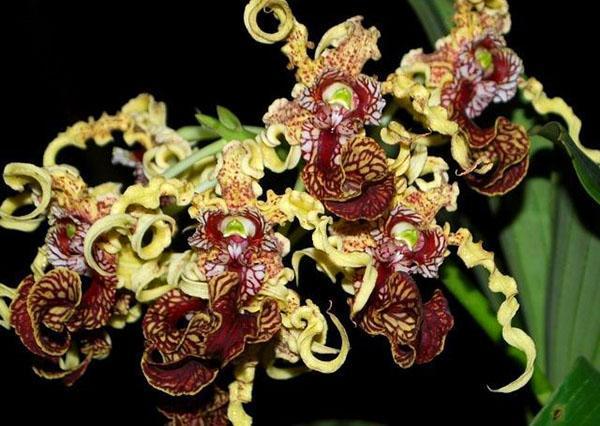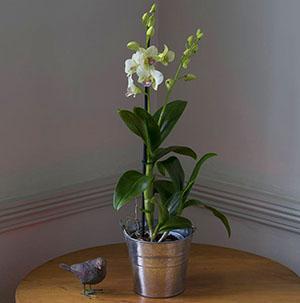To make the Dendrobium orchid happy with flowering, we learn to care for it
 The dendrobium orchid from the southern regions of Asia fell into the hands of botanists, and later also lovers of exotic cultures, at the dawn of the 19th century. To date, several dozen species of these spectacular plants have been described, and in nature they are extremely rare, and some are even classified as endangered representatives of the flora.
The dendrobium orchid from the southern regions of Asia fell into the hands of botanists, and later also lovers of exotic cultures, at the dawn of the 19th century. To date, several dozen species of these spectacular plants have been described, and in nature they are extremely rare, and some are even classified as endangered representatives of the flora.
The situation is completely different with orchids that are specially bred or acclimatized for growing in indoor conditions. This is one of the most sought-after plants from the orchid family. Dendrobium Nobile is considered a recognized favorite among flower growers - orchid with powerful succulent shoots, light green elliptical foliage and beautiful fragrant flowers. Plants of this species were first brought to the Old World in the first half of the 19th century. And for its beauty, dendrobium has earned an addition to the species name, which means “noble”, “excellent”, “famous” (see. types of orchids with photos).

Read also the article:orchid - care and reproduction at home!
Features of the dendrobium orchid
 Dendrobium orchids are predominantly epiphytes, which in nature do not live on the ground, but lead existence, attaching themselves to the trunks, roots and branches of woody plants. Orchids of this genus are of the sympodial type, that is, they form new leaf rosettes on the rhizomes at the base of the old one.
Dendrobium orchids are predominantly epiphytes, which in nature do not live on the ground, but lead existence, attaching themselves to the trunks, roots and branches of woody plants. Orchids of this genus are of the sympodial type, that is, they form new leaf rosettes on the rhizomes at the base of the old one.
Dendrobium shoots, at first erect, and with prolonged growth, becoming lodging, are covered with elliptical or linear leaves. During its life, which lasts from 2 to 4 years, the dendrobium pseudobulb reaches a length of one and a half meters, and then becomes naked and, giving daughter rosettes, dies off.
 In the axils of alternately growing foliage, rudiments of inflorescences or new shoots are formed, which are easy to use when propagating by cuttings for reproduction of the Denbrobium orchid. The flowers are united in tall racemose inflorescences, on which, depending on the type and maturity of the plant, from 5 to 20 corollas can open.
In the axils of alternately growing foliage, rudiments of inflorescences or new shoots are formed, which are easy to use when propagating by cuttings for reproduction of the Denbrobium orchid. The flowers are united in tall racemose inflorescences, on which, depending on the type and maturity of the plant, from 5 to 20 corollas can open.
The shape of the dendrobium nobile orchid flowers and their unique palette do not leave indifferent even experts of this culture. Today you can find and grow plants with white, lilac, orange and even variegated flowers in the room. That is why this species is the most valuable for flower growers all over the world.
What are the conditions for keeping derdrobium nobile orchids and caring for representatives of this unique genus at home?
Conditions for growing dendrobium orchids
 Getting into the house from the store, the dendrobium nobile and orchids of similar species bloom beautifully and often seem ideal, completely non-capricious to the new owner. But without proper care of the dendrobium nobile orchid at home, most likely, it will not be able to bloom again and will probably die.
Getting into the house from the store, the dendrobium nobile and orchids of similar species bloom beautifully and often seem ideal, completely non-capricious to the new owner. But without proper care of the dendrobium nobile orchid at home, most likely, it will not be able to bloom again and will probably die.
The fact is that in greenhouses where plants are grown for commercial purposes, growth stimulants and prolonged-release fertilizers are used, which provide the flower with a supply of nutrients and strength for several months.The sooner the plant gets into suitable conditions and feels the care of the grower, the longer it will be able to delight those around it with amazing flowering, which lasts up to 8 weeks. (Read about the Phalaenopsis orchid and caring for it)
In nature, dendrobiums are plants with a pronounced seasonality. In their development cycle, there are periods of active growth, flowering and rest. And for each such time period, you will have to create your own conditions.
 Dendrobium, rainforest orchids require continuous bright, but not direct lighting. At home, this can be achieved on windows in the south, southeast or southwest direction. In other places, when caring for a dendrobium orchid, you will have to take care of artificial backlight.
Dendrobium, rainforest orchids require continuous bright, but not direct lighting. At home, this can be achieved on windows in the south, southeast or southwest direction. In other places, when caring for a dendrobium orchid, you will have to take care of artificial backlight.
In the warm season, the plant easily tolerates the content in the open air, balcony or loggia, it is only important that the temperature does not drop below 10-12 ° C, and the scorching rays of the sun do not fall on the flower.
If the plant lacks light, dendrobium signals a lack of flowering and a dark shade of foliage. With an excess of sun, the foliage brightens, turns yellow, and in the hot season it withers.
During the active growth period in the summer months, dendrobium thrives at 25 ° C during the day and 20 ° C at night. Hot, dry weather causes the plant to slow down and sometimes stop growing. At this time, one watering is not enough. The flower also reacts positively to irrigation with warm purified water.
With the onset of autumn, the temperature of the content during the day should be 15–20 ° C, at night the air should be additionally cooled to 7–12 ° C. The lighting does not change at this time, but the flower in the cool should be watered much less often. If the care of the derdrobium orchid, as in the photo, is carried out correctly at home, this stimulates the formation of flower buds and the growth of peduncles. As soon as signs of impending flowering appear, the pot is transferred to heat.
 For an orchid in a heated room, it is important to maintain not only the temperature regime and take care of proper lighting. Dendrobium orchid needs high humidity. And if in summer the plant is comfortable in natural conditions, then in winter you will have to use household humidifiers or put the pot on a pallet with wet gravel or moss.
For an orchid in a heated room, it is important to maintain not only the temperature regime and take care of proper lighting. Dendrobium orchid needs high humidity. And if in summer the plant is comfortable in natural conditions, then in winter you will have to use household humidifiers or put the pot on a pallet with wet gravel or moss.
Dendrobium: orchid care at home
In order for the plant to bloom profusely and grow, giving new pseudo-bulbs, it must feel the constant care and support of the grower. Dendrobium orchid care includes:
- regular watering;
- feeding;
- irrigation and showers on especially hot days.
 The plant receives watering especially often throughout the entire period of flowering and growth. But here it must be borne in mind that constant presence in a humid environment for orchid roots is unacceptable. The substrate should dry out between waterings.
The plant receives watering especially often throughout the entire period of flowering and growth. But here it must be borne in mind that constant presence in a humid environment for orchid roots is unacceptable. The substrate should dry out between waterings.
The best way to water is by immersion in filtered water, which is a couple of degrees warmer than the surrounding air. At the same time, soil moistening can be combined with dressings by adding liquid fertilizer for orchids to the water.
You can stimulate flowering by regulating watering and the supply of nutrients to the roots. With the end of the growing season, watering is reduced, and feeding is completely canceled until flower buds appear on the plant again. Early resumption of the usual summer orchid care dendrobium activates not the development of buds, but the growth of daughter rosettes.
Transplantation and reproduction of the dendrobium orchid
 Like other indoor orchids, dendrobium does not relate too well to frequent transplants, so this procedure is carried out no more often than after 2-3 years.
Like other indoor orchids, dendrobium does not relate too well to frequent transplants, so this procedure is carried out no more often than after 2-3 years.
A dendrobium orchid transplant is needed for several reasons:
- with the growth of roots, displacing the substrate from the pot;
- when detecting rot or pests;
- with deterioration in the quality and decomposition of the substrate inside the container.
The plant needs a special coarse-grained soil, which can be bought in a store or made independently from fine expanded clay, crushed moss, coconut fiber, charcoal and coniferous bark.
 A transplant is an excellent reason for carrying out vegetative propagation of the dendrobium orchid. You can get young plants in two ways:
A transplant is an excellent reason for carrying out vegetative propagation of the dendrobium orchid. You can get young plants in two ways:
- using daughter rosettes for planting, formed at the top of an adult pseudobulb;
- having received sprouts from lateral dormant buds of a shoot cut into cuttings.
If the orchid is large enough, you can divide the bush. But at the same time, at least three juicy pseudobulbs are left in each new plant. Old shoots that have lost their elasticity form roots worse and take longer to acclimate.
 For denbrobium orchid cuttings and small rosettes rooted in the substrate, greenhouse conditions are arranged. In bright light, in warmth, plants quickly form roots for independent life. It is possible to transplant the shoots into the ground when several rhizomes with a length of 3 to 5 cm appear.
For denbrobium orchid cuttings and small rosettes rooted in the substrate, greenhouse conditions are arranged. In bright light, in warmth, plants quickly form roots for independent life. It is possible to transplant the shoots into the ground when several rhizomes with a length of 3 to 5 cm appear.